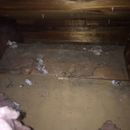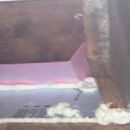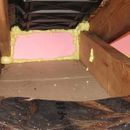1 or 2 rigid foam at top plate around attic baffle?
Just joined, hope this is the right category….Ohio is the state.
I’m going to install attic baffles from new soffit vents. I currently have fiberglass blocking the cellulose, under a plywood floor.
I’ve seen just the baffle, I’ve seen the baffle with a flat piece of rigid foam on top of the top plate and caulked, I’ve seen the flat piece of foam along with a vertical piece, also foamed.
Which is best and why?
(Examples attached-I hope- 1487 is my house with the fiberglass pulled back for the photo.
GBA Detail Library
A collection of one thousand construction details organized by climate and house part












Replies
Jeremy,
Either way will work. However, the photo in the middle has a ventilation baffle that is too short. You want the ventilation baffle to extend far enough for the top of the baffle to be higher than the 16 inches of cellulose that you should be planning to install.
Thank you Martin! That all makes sense.
I'm now thinking about the top of the knee wall and then where that narrow cathedral ceiling like ceiling comes out at the top roof section.
Blocking at either of those spots recommended? I'm trying to wrap my head around it, I think blocking at both would stop air from moving from, in winter, cold to cold through the insulation and it could only go through the attic baffle.
In this diagram I'm talking about beginning and end of the black line labeled "Ventilation baffles when possible"
Sorry, here's the diagram:
Jeremy,
Yes, you need blocking above kneewall top plates (between the rafters) for a proper air barrier. The blocking (usually foil-faced polyiso) should extend up to your ventilation baffles. For more information, see Two ways to insulate attic kneewalls.
Thank you again! At the top I'm leaning towards a blocking, as I think it's a top plate like situation, thought?
Jeremy,
Are you doing that work? If so, it's a pain, isn't it? If not, you're a fortunate man.
I work in education, this will be my spring break project in a few weeks. I won't mind it, it's certainly a "non-sexy" and dirty project but that's ok. Nothing to really photograph to show people after either, but hopefully cooler upstairs in summer, fewer ice dams in winter and lower energy bills overall:)
2 final questions where I'm still not totally clear?
1. With blocking air sealing the baffle at the top of the kneewall do I also put blocking at the top of the sloped/cathedral ceiling to also seal around the top exit of the baffle or leave that open?
2. My soffit is basically a wooden box that's out and below the attic floor, as shown in the first picture. I'm thinking the bottom of the baffle goes below the flat foam piece that will sit on the top plate for sure, but not down so far as to bottom out on the bottom of the soffit, where it may sit to far out from the actual vent. Is this a correct line of thinking, to seal the bottom of the baffle into that box, not necessarily to the bottom of it? It will of course be stapled to the roof sheathing.
Jeremy,
Q. "My soffit is basically a wooden box that's out and below the attic floor, as shown in the first picture. I'm thinking the bottom of the baffle goes below the flat foam piece that will sit on the top plate for sure, but not down so far as to bottom out on the bottom of the soffit, where it may sit to far out from the actual vent. Is this a correct line of thinking?"
A. Yes.
Concerning your first question: I'm not sure I understand, but here are the principles:
(1) You need to know the boundary of your thermal envelope. This boundary needs an air barrier, and the air barrier needs to be continuous and in contact with your insulation. You don't want any air leaks or any hidden channels where air can escape.
(2) Above your insulation layer, but below your roof sheathing, you need a continuous ventilation channel from your soffit to your upper attic or ridge vent. This ventilation channel should not be impeded or blocked.
Sorry if I wasn't clear.
"(2) Above your insulation layer, but below your roof sheathing, you need a continuous ventilation channel from your soffit to your upper attic or ridge vent. This ventilation channel should not be impeded or blocked."
The insulation layer-it has drywall interior of it, the attic baffle/ventilation channel above it, and blocking on the lower end of it. My question is if the insulation layer has blocking on the upper end. This blocking would enclose just the insulation layer. I'm not sure what air it would be block, as the other (lower) end of the insulation layer is already blocked.
My attic baffles will be retro fitted by being slid above the insulation layer if it matters, I won't be able to staple them in in the middle as it's already a finished ceiling if that matters.
Yes, you need blocking to enclose the insulation at the upper end.